The Center for Latin American Studies at the University of Arizona hosts virtual Charlas con café – a weekly space to hear lectures from a wide variety of experts and discuss topics relevant to the Latin American region, Fridays from 1-2 p.m.
0 Comments
By Janet Sanderson 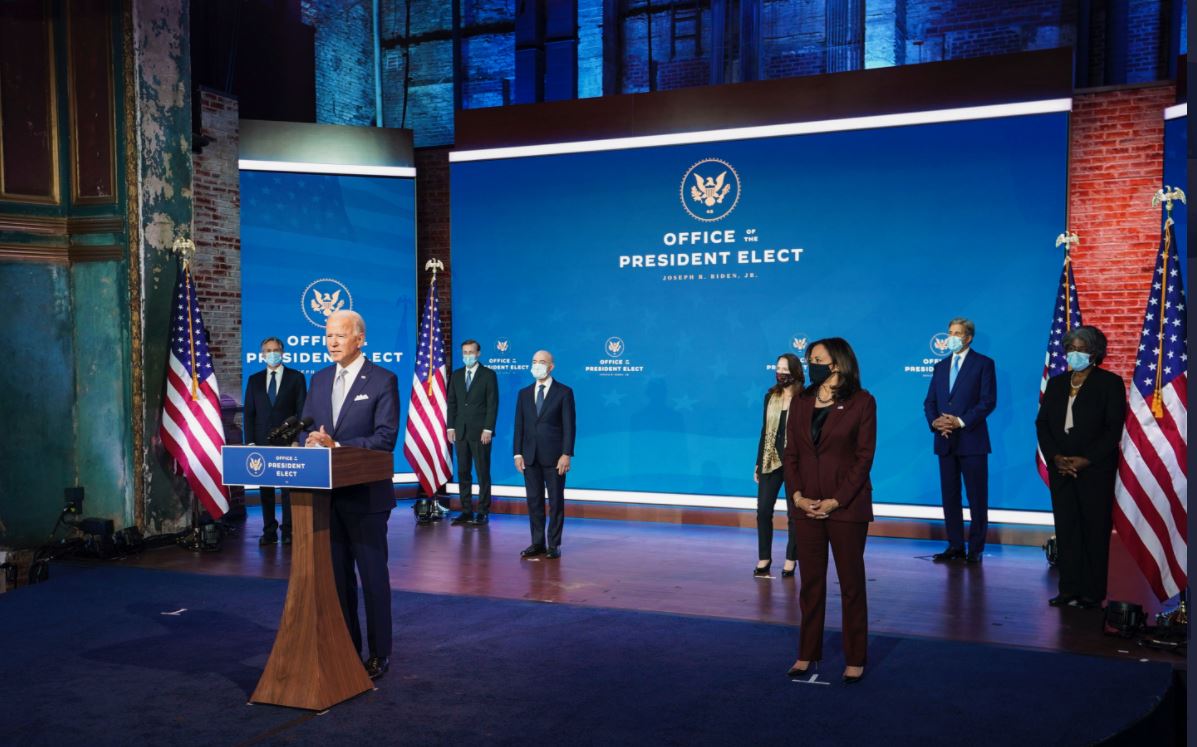 That wasn’t a breeze you felt when President-Elect Biden unveiled his foreign policy team yesterday but rather a huge sigh of relief from America’s friends, allies, foreign policy wonks and practitioners. I was one of them. Biden’s selection of well-regarded, veteran foreign policy professionals points to an important but often underestimated element necessary for a successful foreign policy: stability. The challenges and threats we now face, and will face in the future, are neither constant nor necessarily predictable. The team that we field to deal with them therefore must be. Entertaining as the dramatic diplomatic gesture is, in my experience it rarely achieves its end. Even the most audacious act — Nixon’s surprise visit to China or Reagan’s “Tear Down this Wall” challenge—required careful spadework and choreography. So I cheered Biden’s foreign policy team. I worked alongside many of them in my final years as a Foreign Service Officer, first as Ambassador to Haiti and then as Deputy Assistant Secretary of State for Near East Affairs. I don’t claim close friendship with any of them and in retirement I’m a rank outsider. But I sat in Situation Room meetings with them, shared notes, and briefed some of them on a regular basis during the early years of the Obama administration. We didn’t always agree on issues and I hope we would all acknowledge that the Obama years had its share of foreign policy failures and blunders. But let me offer some thoughts as to why I am enthused about those whom Biden has called to our nation’s service. They are deeply experienced public servants. They don’t need to be “read in”. They won’t be training on the job. Beyond their CVs, they bring a wealth of contacts, networks, and perspectives to the table. Their individual backgrounds may be varied but they share a vision of America’s role in the world and how it can best serve the American people. I am confident that they will learn from the foreign policy miscalculations of the past and question assumptions as they go along. Jake Sullivan was particularly adept at that in the State Department: I vividly remember one exchange on U.S. democratization programs in the Middle East in which he pushed a recalcitrant bureaucracy to reexamine its assumptions about long-established policies. This team is close to the president-elect. When I was posted in the Middle East, Tony Blinken was known to us as the guy behind Joe Biden on the congressional plane, notebook in hand. Later, when I was shepherding senior Middle East visitors to the White House, it was no surprise to see him popping up at meetings, whispering in the vice president’s ear. It certainly answers the question Ambassadors always get from their host government: how close is the new Secretary of State really to the president? They care about friends, allies and institutions. If their first statements are any indication, the new team will rebuild relationships with old friends and recommit the United States to those international institutions that best serve our interests. Biden’s decision to re-enter the Paris Climate Accord and the World Health Organization, his insistence on orderly outreach to world leaders in the transition period (chronicled in the regular release of press announcements), and his decision to re-establish the UN ambassadorial portfolio as a Cabinet position serve notice that U.S. will seek a more engaged relationship with the world. The Biden team is unlikely to simply revert to past habits, however. The world has changed greatly since many of them left office; how well they adapt, adjust and respond to those changes will help determine the success or failure of the new administration’s foreign policy. Institutions at home matter as well. My old home, the Department of State, is in shambles. The presence of career Foreign Service Officer Ambassador Linda Thomas-Greenfield who, as Director General of the Foreign Service pushed the Department to become more open, responsive and representative of America, assures me that the Biden Administration will follow through on its promise to reinvigorate the Department. Failure to do so, and to address the systemic personnel and bureaucratic impediments that have long hobbled our premier foreign affairs agency, would be diplomatic malpractice. Only a total rethink of the Department will allow it fully step up to support America abroad. Process Matters. Almost every major government agency and department have foreign policy equities which the bureaucracy must serve. Keeping all those players involved and interacting makes better, more transparent, more effective policy. Something as simple as senior-level travel abroad can have broad foreign policy implications: when I worked with Sullivan and his staff to prepare for the Secretary of State’s visits to the Middle East in the wake of Arab Spring, Secretary Clinton’s agenda included press freedoms, counterterrorism funding issues, human rights meetings, military assistance packages, Iranian sanctions policy, women’s rights, renewable energy, nuclear safeguards, military cooperation. Now, consider the hundreds of pressing foreign policy issues the U.S. confronts. It’s herding cats, yes, but demonstrates the centrality of the NSC in organizing the government’s foreign policy. They care about public service and the people that serve. I truly believe public service is a difficult, if personally rewarding, calling. And good public service is essential to our health of our democracy. So it’s reassuring to see leaders who share that view. You’ve heard about Ambassador Linda Thomas-Greenfield’s Gumbo Diplomacy, but LTG stories are legion in the State Department. She’s one of our stars: forthright, funny, smart. Supportive of her people. And passionate about making the State Department more representative of America. She does the unexpected. Her staff at our embassy in Monrovia still talk about her picking up trash outside the embassy gates in the morning. Not what ambassadors usually do. I confess I didn’t. Leadership matters. Blinken, Sullivan, Thomas-Greenfield, DNI Director-Designate Avril Haines and the others, working alongside colleagues at home and abroad, will do the foreign policy spadework. But make no mistake: that policy will be driven by Joe Biden. He won’t contract it out or delegate it. He has an abiding interest in promoting America’s interests abroad, in building and nurturing partnerships, in connecting with people. I saw that on his congressional travels to the Middle East. He knew his brief. He asked smart questions. He listened. He was a hit with his hosts, even when delivering a difficult message. And he always thanked our Embassy staff, both American and local, for their support of his visit. That gesture was rarer that you might suppose. One last note on President-Elect Biden. In February, 2009, when I was U.S Ambassador to Haiti, President René Préval of Haiti asked that I organize an Oval Office meeting with President Obama. Préval had apparently told his fellow Caribbean leaders he would be the first among them to meet the new president. Now, it’s axiomatic in Washington that the first months of a new president’s term is focused on domestic issues so I was not surprised when the White Houses took a pass. But Joe Biden immediately stepped in. Mindful of the relationship that we were cultivating with the Préval and the importance of the U.S./Haitian relationship, Biden hosted an intimate meeting in his private office. Préval talked at length; Biden never rushed him. The Haitian President left charmed. It certainly made my job easier. Grace notes sometimes matter as much as competence and vision. The most successful leaders combine all three. That’s what Joe Biden and his team now bring to the White House— and to the American people. Janet Ann Sanderson is a former American diplomat and an adjunct professor of international relations at Georgetown University. During her 34-year career as a foreign service officer, she served as U.S. Ambassador to Haiti and U.S. Ambassador to Algeria, among other assignments.  Ambassador Nicholas Burns addresses TCFR members at Skyline Country Club on Thursday, Feb. 21, 2019. Ambassador Nicholas Burns addresses TCFR members at Skyline Country Club on Thursday, Feb. 21, 2019. Following Ambassador Nicholas Burnsʼ excellent talk to TCFR on February 21, 2019, the ambassador was interviewed by Christopher Conover of Arizona Public Media. Mr. Conover later interviewed Steven Hall, retired member of the CIA Senior Intelligence Service, who opened the current TCFR season with his talk in September 2018. The two interviews recently ran on AZPMʼs public affairs radio program, “The Buzz.” The following link will take you to the program and also to the complete audio of Ambassador Burnsʼ talk to TCFR: https://radio.azpm.org/p/radio-buzz/2019/3/7/147469-changing-us-foreign-relations/ PRESS RELEASE - University of Arizona College of Engineering John Boright, Executive Director of International Affairs of the U.S. National Academies of Sciences, Engineering and Medicine
John Boright will talk about contrasts, relationships and lessons learned in his various roles as a government official on nuclear nonproliferation and nuclear energy use, a United State Embassy and State Department science counselor, and at the National Academies building capacity and partnerships to meet major global challenges, especially in the least developed countries. His talk will cover perspectives on nuclear power in the context of climate change and nuclear risks, and cooperation to meet urgent human needs in the presence of issues of human rights and strong national policy disagreements. In 1994-1995, Boright was Deputy to the Associate Director for National Security and International Affairs at the Office of Science and Technology Policy in the Executive Office of the President, after spending five years as Deputy Assistant Secretary for Science and Technology Affairs at the Department of State overseeing U.S. science and technology agreements with other countries, and international space policy and program matters. In 1987-1989 he was Director of the Division of International Programs at the National Science Foundation, where he developed international cooperative arrangements and U.S. access to science and engineering in other countries, particularly with Japan and countries in Asia and Eastern Europe. Before that he worked for 10 years at Department of State and has worked at the Goddard Space Flight Center, the U.S. Arms Control and Disarmament Agency, and the U.S. Mission to the International Atomic Energy Agency in Vienna, Austria. He is a member of Phi Beta Kappa and received his BA and PhD in physics from Cornell University. 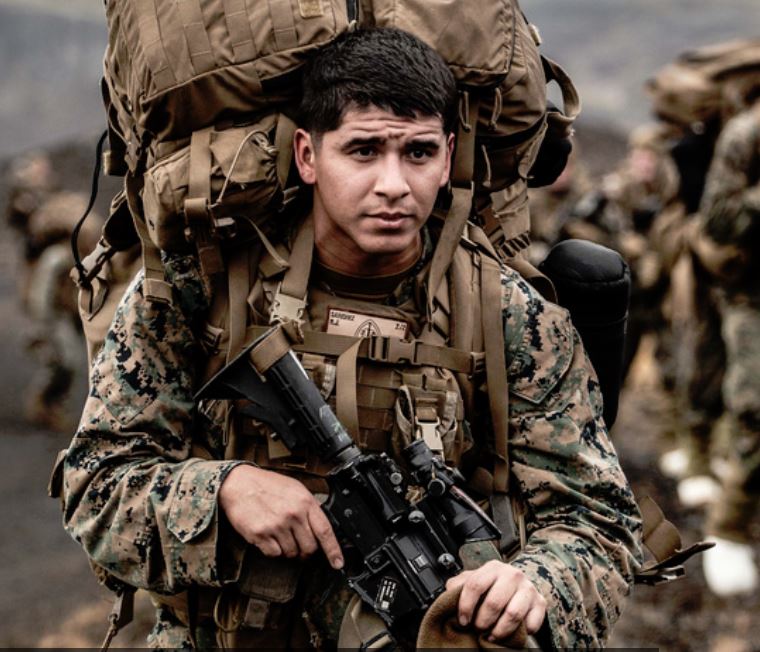 PRESS RELEASE - Belfer Center for Science and International Affairs, Harvard Kennedy School Cambridge, MA—As the 70th anniversary of the North Atlantic Treaty Organization (NATO) approaches, the world’s oldest and most successful military alliance of democratic nations faces serious and complex challenges to its purpose, effectiveness, and unity in 2019. Former U.S. Permanent Representatives to NATO Douglas Lute and Nicholas Burns highlight ten major challenges to NATO in a new report, NATO at Seventy: An Alliance in Crisis, and offer recommendations to bolster this critically important alliance. Burns, who is Faculty Chair of The Project on Europe and the Transatlantic Relationship at Harvard Kennedy School’s Belfer Center, and Lute, a Senior Fellow with the Europe Project, will discuss the report during events at the Munich Security Conference on Friday, February 15. “NATO is facing one of its most difficult crises in seven decades,” said Nicholas Burns. “While NATO has strategic challenges to meet, the single greatest threat is the absence of strong, principled American presidential leadership for the first time in its history.” Douglas Lute said, “We hope that this report serves as food for thought within the Alliance, prompting attention to tough, strategic challenges and deep introspection among the allies. NATO should move revitalized and retooled into the decades ahead, and again demonstrate its ability to adapt.” Based on extensive discussions with current European and North American leaders, former senior officials, academics, and journalists, Burns and Lute recommend that Congress pass legislation this year to protect NATO, such as requiring Congressional approval should President Trump attempt to alter U.S. treaty commitments to NATO allies or seek to take the U.S. out of the Alliance altogether. They also offer recommendations on how NATO should cope with low European defense spending, Russia’s continued aggression in Eastern Europe, anti-democratic governments within NATO, Afghanistan, China and more. The authors recommend action in these areas: Challenges from Within NATO
Read the full report here. By Elliott Weiss 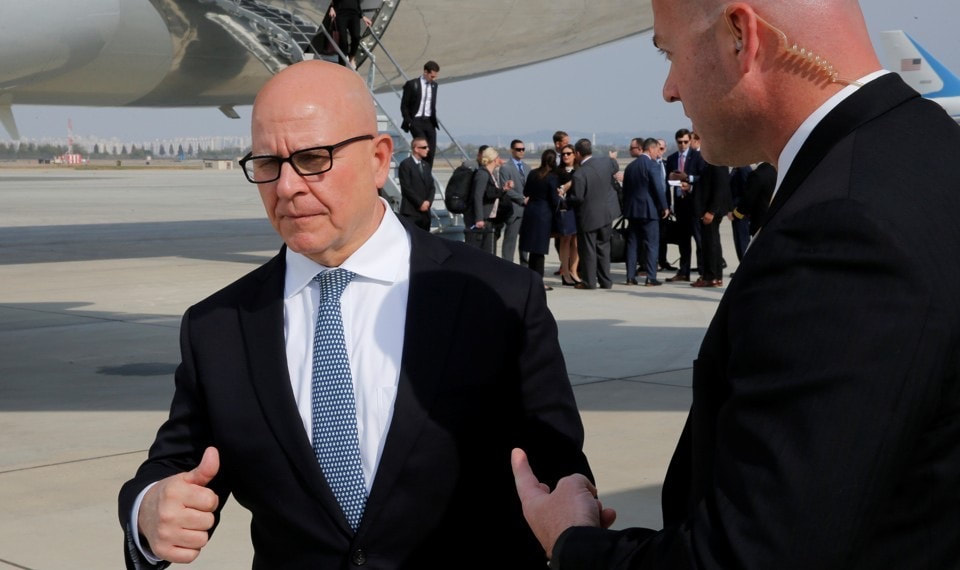 National Security Advisor H.R. McMaster speaks with an aide on the tarmac at Osan Air Base, South Korea, on November 7 2017. (Jonathan Ernst/Reuters) In November, Dr Patrick McEachern spoke about what North Korea’s goal is in developing nuclear weapons capable of reaching the mainland United States. He suggested that Kim Jong Un’s objectives were to protect his country against an American attack, nuclear or otherwise, and to preserve his regime. Kim, he suggested, was determined not to suffer the same fate as Saddam and Quadaffi, two other dictators who had been deposed after agreeing to abandon their nuclear weapon programs.
A recent article in The Atlantic outlines the thinking of H.R. McMaster, President Trump’s National Security Advisor, on troublesome issues posed by North Korea’s nuclear weapons program. Gen. McMaster thinks it is likely that Kim’s principal goal is to have the capability to threaten the United States with a nuclear attack if it seeks to block an attack by the North’s conventional forces against South Korea. This view is encapsulated in the question “Would the United States Government risk Seattle to save Seoul?” Gen. McMaster’s thesis varies from the hypotheses discussed by Dr. McEachern. I thought that members of TCFR, especially those who attended Dr. McEachern’s talk, would find it interesting to consider this contrasting point of view. You can find it discussed at some length here. Elliott Weiss, a retired attorney and professor of law, is a director of TCFR and the chair of the board’s Nominating Committee. By Thomas J. Volgy (Photo source: Business Insider, captured January 16, 2018)
With the possible exception of the early years of American atomic capabilities (from the mid-1940s through the mid-1950s), we became not only the most sophisticated nuclear power in the history of the world, but also the one country I was completely convinced would never respond with nuclear weapons against non-nuclear threats. There was some flirtation with a first-strike policy, especially during the days of Ronald Reagan’s “evil empire” moment, but even such horrible flirtations were imagined only in the context of substantial nuclear threats by a comparable nuclear power (the Soviet Union). So, today I was astonished to learn from the pages of the New York Times ("Pentagon suggests countering devastating cyberattacks with nuclear arms", January 16, 2017) that the Pentagon has formally recommended to the White House the use of nuclear weapons in response to a range of threats that are not nuclear threats to the United States. These would include “large” scale cyberattacks. This is not the first time the Pentagon has proposed use of nuclear weapons under “extreme circumstances”; it did so as well under the Obama Administration. But what has changed here is a broadening of what is considered extreme, to include cyberattacks as well. I can understand the concern. A well-coordinated cyberattack on U.S. infrastructure would cause havoc with our economy, with society in general, and perhaps have a dramatic impact on the Pentagon’s command and control operations. It would be “huge”. But does it warrant the first-strike use of nuclear weapons? Is it possible that we would plan to use nuclear weapons against countries that don’t have nuclear capabilities? Is it possible that a military that consumes over $600 billion annually does not have in its arsenal responses that would not require the first-use of nuclear weapons? The strategy envisions the manufacture and deployment of a new generation of “small, low-yield” nuclear weapons to be used in these “extreme” circumstances. What for? We really don’t have enough punching power in our incredibly large, technologically impressive arsenal and so we are willing to seriously entertain nuclear usage in this type of confrontation? Apart from the expense (approximately $2 trillion to upgrade our nuclear arsenal) and the horror of nuclear use, there is awful lot here that requires further examination and questioning. Historically, the heavy investment in nuclear capabilities was primarily justified in terms of deterrence against the Soviet Union. As long as the Kremlin understood that any nuclear first strike attempt on their part would guarantee a retaliation that would destroy the Soviet Union completely, the policy assured that Moscow’s leadership would commit suicide by starting this type of war, and therefore would not do so. And at some level, deterrence worked. In fact, it worked so well that no nation with nuclear capabilities (apart from our bombing of Hiroshima and Nagasaki during World War II) has ever used its nuclear weapons against another, even when its opponent had no capacity to retaliate with nuclear weapons. It is a threshold that no nation wanted to cross. Now, what has changed? Possibly this is another deterrence strategy, warning cyberbullies that they face the threat of nuclear weapons should they engage in a serious cyberattack on the United States. Unfortunately, history has taught us that deterrence attempts on the part of a nuclear power against a nation without nuclear weapons does not work. No one can put the nuclear genie back into the bottle. But until now, the world has done a pretty good job in not letting it out all the way. That could soon change. It is not a legacy I am willing to leave to my children. Before we go much further down this road, we should rethink where we are going. A first-use doctrine of this sort invites fear and mimicking on the part of those nations who can also build such weapons and could soon deploy them. That would make for a far more dangerous world than the Pentagon’s assessment of how troubled the world actually seems at the moment. Tom Volgy is a Professor of Political Science at the University of Arizona and the former Executive Director of the International Studies Association. By Thomas J Volgy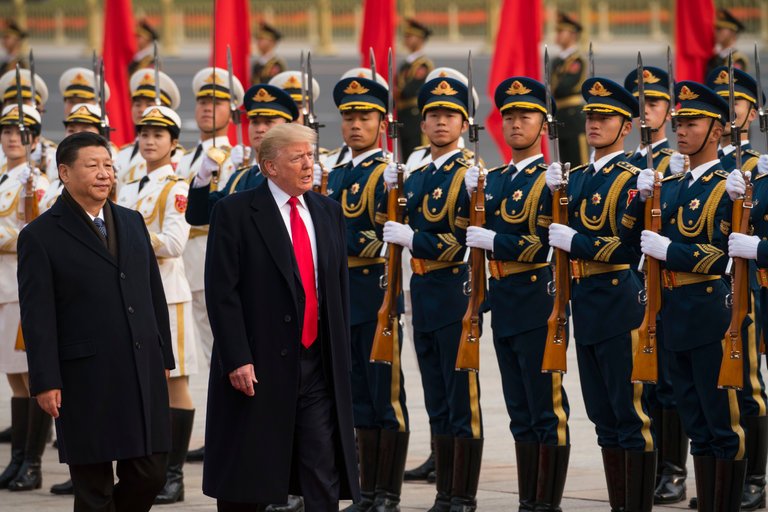 (Presidents Trump and Xi inspecting troops in Beijing, November 9, 2017. Photo courtesy of New York Times) As a close observer of international relations, it is difficult to read what the U.S. President just said in China. According to news accounts he indicated that China had left America “so far behind”, blamed previous U.S. administrations for our trade imbalance, seems to have suggested that the U.S. needs China more than China needs the U.S., and thus created the impression of an imbalance in power relations favoring the Chinese, praised President Xi for consolidating his power as an autocrat, and called Xi “a very special man” (New York Times, November 9, 2017). According to the New York Times, the warm embrace was not reciprocated by President Xi, and to many Chinese the U.S. President appeared to come as a supplicant, rather than representing the most powerful country in the world. Does any of this matter? Most U.S. Presidents (if not all) make sure that they project American power, not because they feel good doing so (which they probably do), or because it plays well with domestic audiences (which it does), but because such projection carries with it substantial “soft power”: it confers on the U.S. a very special status of being the strongest of major powers, and grants us additional influence over the course of global affairs. Doing the opposite, which appears to be the case with Trump’s China visit, simply underscores the claims of Chinese and Russian foreign policy makers that American global leadership and American global power have come and gone. And that’s not true. I have not met a single person with good knowledge of China, either in North America or in Europe, who wanted to move there to live because it was a better country in which to live. In what way has China left us “so far behind”?
Have the Chinese left us behind? Facts suggest the very opposite. It is dangerous for an American president to say that they have. Saying it increases the prospects that leaders of other states will begin to believe it, and diminish our abilities to pursue our foreign policy objectives. Perhaps even more important, Chinese leaders may begin to believe it as well. It may become the ultimate foreign policy irony of this Administration that on the way to trying to "make us great again," our global "influence" will substantially diminish as a result of the actions and words coming from this White House. Tom Volgy is a Professor of Political Science at the University of Arizona and the former Executive Director of the International Studies Association. By Robert Thompson
On April 6, 2017, 59 Tomahawk cruise missiles launched from U.S. Navy warships struck an air base in Syria. The attack was in retaliation for the horrifying use of chemical weapons, presumably ordered by the Assad regime, against Syrian civilians. Much discussion followed concerning President Trumpʼs authority to launch the strike without Congressional approval, but less attention has been paid to the legitimacy of the missile strike under international law. Sovereignty is a fundamental principle of international law. States have broad freedom to act as they choose within their own borders and in dealing with their own people, whether or not others like what they do. The freedom of sovereign states is not absolute, however. There is a balance between the rights of state sovereignty and the stateʼs obligations under customary and treaty- based international law. Of particular relevance to this discussion, the Geneva Protocol of 1925 established the illegality of use of chemical weapons in warfare, and the 1993 Chemical Weapons Convention prohibited production, storage, and transfer of such weapons, as well as their use. Syria is a party to both treaties. So how is the conflict between state sovereignty and responsibility for the gassing of Syrian men, women, and children to be resolved? Justifications for the unilateral strike initially offered by the Administration included a strained claim of self-defense (the need to keep chemical weapons out of the hands of terrorists). But Syria has neither attacked nor directly threatened other states. The legal case must rest on a different foundation. In 2005 the United Nations World Summit adopted the principle of Responsibility to Protect (often referred to as R2P). Under this principle a state has a responsibility to protect its own people from mass killings and other egregious violations of human rights. If the state fails to satisfy that responsibility, intervention by other states can be justified. But under R2P the use of force against an offending state is a last resort (after more pacific efforts). Military action is permitted only in cases of genocide, war crimes, ethnic cleansing, and crimes against humanity, and then only with UN Security Council authorization. Obtaining Security Council authorization for the U.S. missile strike would not have been a practical possibility with Russia and China having veto power in that body. In 2011 the Security Council did authorize (with Russia and China abstaining) military intervention in Libya to prevent atrocities by the Qaddafi regime, but authoritarian regimes consistently resist diminution of sovereignty, and, of course, Russia has a direct interest in supporting the Assad regime. So R2P cannot be the legal basis of the missile strike in Syria. But that is not the end of the story. Humanitarian intervention is a concept much older and less institutionalized than the formality of R2P. Under customary international law humanitarian intervention simply involves military force used or threatened against a sovereign state and motivated by humanitarian objectives. Ideally military action justified as humanitarian intervention would be multilateral, as was NATO bombing in the Kosovo conflict in 1999, but that has not always been the case. Because of the conceptual elasticity of humanitarian intervention, and because it challenges the fundamental principle of sovereignty, humanitarian intervention has always been controversial, but it is a recognized part of the framework of international law. The unconscionable acts perpetrated against the Syrian people for years by the Assad government, culminating in this most recent outrage of chemical attacks, manifestly justify the missile strike of April 6. The legal case based on humanitarian intervention is sound, if not universally embraced. It is virtually impossible to contest the moral case. Robert Thompson is a retired lawyer and international business executive. He currently is president of the Tucson Committee on Foreign Relations. By Robert Thompson
On February 1, 2017, the American Society of International Law offered the first in a series of free, nonpartisan, online briefings on “International Law and the Trump Administration.” The initial briefing examined “The Future of International Agreements” and was moderated by Michael Goldhaber, a journalist specializing in international legal matters. The expert commentators were Catherine Amirfar and John Bellinger, both former State Department lawyers (he in the George W. Bush administration and she in the Obama administration) and both currently practicing international law with major law firms. The hour-long program was geared to an audience of policy makers, journalists, and the general public. Donald Trump has expressed negative views of international law, international institutions, treaties, and other international agreements. A draft Executive Order leaked after Mr. Trump became president would direct a review of all multilateral treaties to determine from which of them the Administration might choose to withdraw. Mr. Ballinger noted it is customary for a new administration to order a review of pending treaties in order to prioritize among them, but a review of all treaties both pending and in force would encompass hundreds of instruments and suggests a skepticism both commentators regarded as troubling. The specific benefits of treaties are many, the commentators observed, and the values of free and open societies are spread across the globe through treaties and other international agreements. Ms. Amirfar described the three legal categories of international agreements and the standards for each coming into effect under U.S. law. Treaties require approval by a two-thirds vote of the Senate. Congressional-Executive Agreements are approved by a majority of the House and Senate. Sole Executive Agreements can be entered into (and withdrawn from) by the president, pursuant to Constitutional or statutory executive authority and without concurrent Congressional involvement. Boundaries between the types of international agreements are largely guided by tradition but can be subject to debate. There is little legal precedent concerning the president’s unilateral power to withdraw from treaties and international agreements. In the past the Supreme Court (in Goldwater v. Carter, 444 US 996 (1979)) has found such treaty withdrawal to be a non-justiciable political issue not ripe for judicial review. The panel explored the prospects for several international agreements, principles, and institutions that drew specific attention in the recent campaign: NAFTA, the Paris climate change agreement, the Iran nuclear deal, the World Trade Organization, the principle of sovereign immunity, the International Criminal Court, and U.N. Human Rights conventions. Each situation is different, and the difficulty of withdrawing from or modifying the U.S. position on each varies. For example, the Paris agreement is so minimally binding and aspirational that it has not been submitted to the Senate, so the president could essentially ignore it if he chooses. On the other hand, NAFTA (a Congressional-Executive Agreement) contains specific procedures for withdrawal on six months notice (it is not clear whether the president could act unilaterally to withdraw). But the economies of the parties to NAFTA are so intertwined that the practicality of withdrawal is questionable. Both commentators expressed hope that once the full Cabinet is in place and a more normal process of consultation and inter-agency dialogue begins to take place the international system that has dramatically raised global standards of living will remain intact. A video recording of the February 1 discussion can be viewed at www.asil.org/100days. The second briefing in the series, on “The United Nations and Its Specialized Agencies,” will take place on February 23, 2017, at 9:30 a.m. (MST). Robert Thompson is a retired lawyer and business executive. He currently is president of the Tucson Committee on Foreign Relations. |
TCFR MembersA Blog by TCFR Members for the TCFR membership. We invite you to read the Welcome Letter here. The blog guidelines are available for review here. Archives
February 2021
Categories |
Tucson Committee on Foreign Relations, Inc., P.O. Box 32076, Tucson, AZ 85751
Copyright © 2019-2022
Copyright © 2019-2022

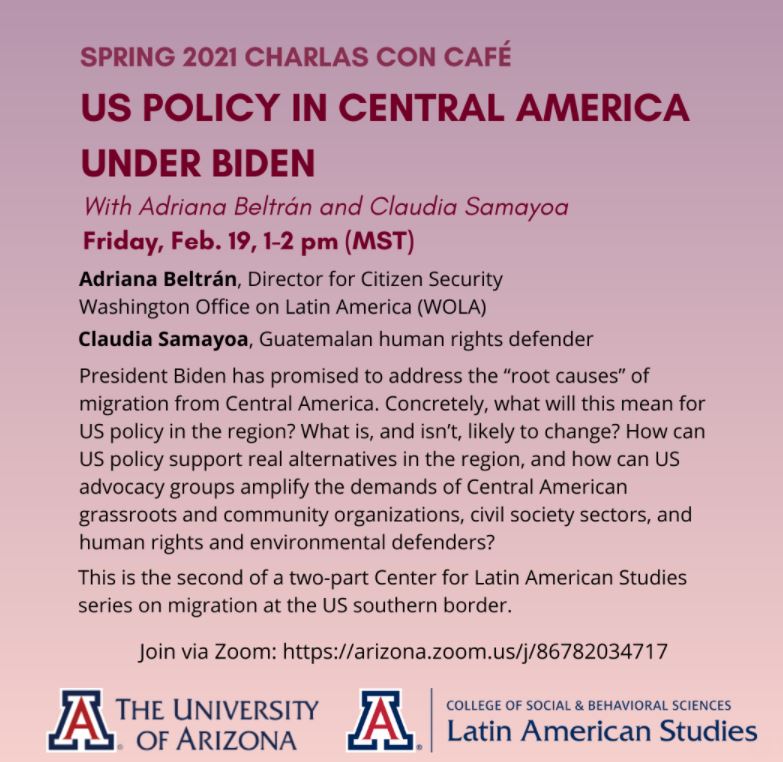
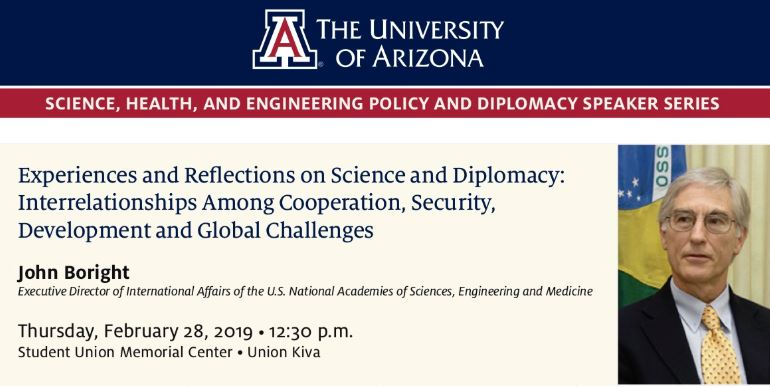
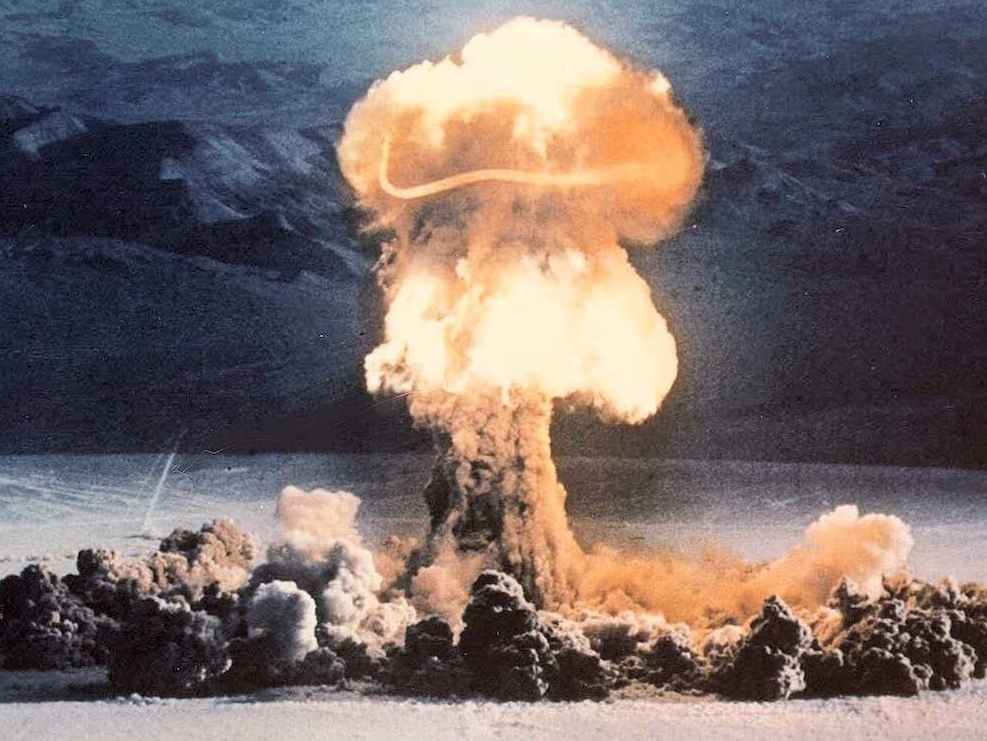
 RSS Feed
RSS Feed